- Home
- About
- Map
- Trips
- Bringing Boat West
- Migration West
- Solo Motorcycle Ride
- Final Family XC Trip
- Colorado Rockies
- Graduates' XC Trip
- Yosemite & Nevada
- Colorado & Utah
- Best of Utah
- Southern Loop
- Pacific Northwest
- Northern Loop
- Los Angeles to NYC
- East Coast Trips
- Martha's Vineyard
- 1 Week in Quebec
- Southeast Coast
- NH Backpacking
- Martha's Vineyard
- Canadian Maritimes
- Ocracoke Island
- Edisto Island
- First Landing '02
- Hunting Island '02
- Stowe in Winter
- Hunting Island '01
- Lake Placid
- Chesapeake
- Provincetown
- Hunting Island '00
- Acadia in Winter
- Boston Suburbs
- Niagara Falls
- First Landing '99
- Cape Hatteras
- West Coast Trips
- Burning Man
- Utah Off-Roading
- Maui
- Mojave 4WD Course
- Colorado River Rafting
- Bishop & Death Valley
- Kauai
- Yosemite Fall
- Utah Off-Road
- Lost Coast
- Yosemite Valley
- Arizona and New Mexico
- Pescadero & Capitola
- Bishop & Death Valley
- San Diego, Anza Borrego, Joshua Tree
- Carmel
- Death Valley in Fall
- Yosemite in the Fall
- Pacific Northwest
- Utah Off-Roading
- Southern CA Deserts
- Yosemite & Covid
- Lake Powell Covid
- Eastern Sierra & Covid
- Bishop & Death Valley
- Central & SE Oregon
- Mojave Road
- Eastern Sierra
- Trinity Alps
- Tuolumne Meadows
- Lake Powell Boating
- Eastern Sierra
- Yosemite Winter
- Hawaii
- 4WD Eastern Sierra
- 4WD Death Valley +
- Southern CA Deserts
- Christmas in Tahoe
- Yosemite & Pinnacles
- Totality
- Yosemite & Sierra
- Yosemite Christmas
- Yosemite, San Diego
- Yosemite & North CA
- Seattle to Sierra
- Southwest Deserts
- Yosemite & Sierra
- Pacific Northwest
- Yosemite & South CA
- Pacific Northwest
- Northern California
- Southern Alaska
- Vancouver Island
- International Trips
- Index
- Tips
- Books
- Photos/Videos
- Search
- Contact
Athens, Greece
Tuesday, October 18, 2022 - 5:30pm by Lolo
245 miles and 9.5 hours from our last stop - 1 night stay
Travelogue
.thumbnail.jpg) The National Archaeology Museum of AthensOur 9/12-hour ferry from Crete delivered us to Athens, well rested and in time for breakfast back at the Acropolis Select, the hotel we had stayed in when this adventure started.
The National Archaeology Museum of AthensOur 9/12-hour ferry from Crete delivered us to Athens, well rested and in time for breakfast back at the Acropolis Select, the hotel we had stayed in when this adventure started.
Tassos did not let any moss grow under our feet. Right after breakfast we boarded our bus, which took us to the National Archaeological Museum, which holds the world’s best collection of ancient Greek Art. Now that we had been in Greece for two weeks and seen so much, it would be a nice wrapup to our tour.
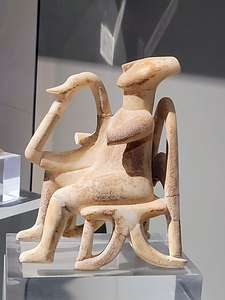 Cycladic Male-Seated Harp PlayerI love Art History and often spend my spare time reading Art History textbooks, so I was very excited to see some familiar favorites.
Cycladic Male-Seated Harp PlayerI love Art History and often spend my spare time reading Art History textbooks, so I was very excited to see some familiar favorites.
The museum traces the history of Greece’s various civilizations: the Minoans, the Mycenaeans, Archaic Greece, the Classical Age, Alexander the Great, and the Romans. That’s a lot of millennia to cover.
The exhibits are displayed chronologically so we started our journey in the early Bronze Age with a terracotta figurine called "The Thinker", estimated to have been made around 4000 BCE. While its purpose is unknown, it is thought to have been some sort of fertility figure. I thought he was adorable.
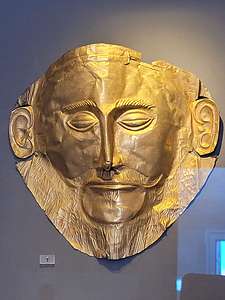 Death Mask of AgamemnonNext up was the Cycladic collection, featuring the famous marble figurines from the Aegean islands of Delos and Keros. These mysterious human representations, which resemble modern art, came from the 3rd millennium BCE old cemeteries throughout the Aegean islands, along with bronze tools and containers. This more intricate example is called the Male-Seated Harp Player. It was found on the island of Keros and dates from the Early Cycladic period (2800 - 2300 BCE). Amazing to think this finely detailed figure was sculpted around 5,000 years ago. Need I say, he was adorable too.
Death Mask of AgamemnonNext up was the Cycladic collection, featuring the famous marble figurines from the Aegean islands of Delos and Keros. These mysterious human representations, which resemble modern art, came from the 3rd millennium BCE old cemeteries throughout the Aegean islands, along with bronze tools and containers. This more intricate example is called the Male-Seated Harp Player. It was found on the island of Keros and dates from the Early Cycladic period (2800 - 2300 BCE). Amazing to think this finely detailed figure was sculpted around 5,000 years ago. Need I say, he was adorable too.
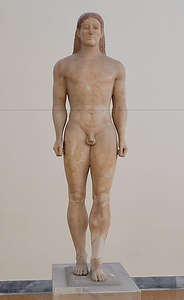 Archaic period kousosMoving along chronologically, we next came to Room 4, which displays artifacts found in the ruins of the ancient mainland fortress-city of Mycenae, which flourished from 1600 - 1200 BCE. This was the civilization that theoretically battled Troy in Homer’s Iliad.
Archaic period kousosMoving along chronologically, we next came to Room 4, which displays artifacts found in the ruins of the ancient mainland fortress-city of Mycenae, which flourished from 1600 - 1200 BCE. This was the civilization that theoretically battled Troy in Homer’s Iliad.
I immediately recognized what Henry Schliemann named the “Death Mask of Agamemnon.” The mask is made of beaten gold and it was once placed tied over the face of the deceased.
More accurate dating technology, however, showed that it was made several centuries before Agamemnon lived. Oh well.
Some of the earliest surviving examples of the post-Mycenaean, or Archaic Age (700 to 480 BCE), of ancient Greece are life-sized, and some even larger than life-sized, statues of clothed young women (kore/korai) and naked young men (kouros/kouroi).
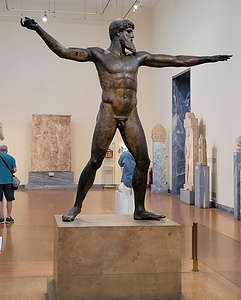 Artemision Bronze (Zeus or Poseidon?)You can see the Egyptian influence in their stiffness, triangular faces, and arms held at their side, except unlike the Egyptian statues, these Archaic Greece statues are actually freestanding and even have some empty space between their legs.
Artemision Bronze (Zeus or Poseidon?)You can see the Egyptian influence in their stiffness, triangular faces, and arms held at their side, except unlike the Egyptian statues, these Archaic Greece statues are actually freestanding and even have some empty space between their legs.
The statues of this period are rather expressionless with the characteristic Archaic smile, a small smile or smirk that was meant to suggest that the subject was alive and in good health. Very little personality comes through during this period.
Continuing on, we came to a room with the Artemision Bronze, discovered amid a 150 BCE shipwreck off Cape Artemision (north of Athens) in 1928. The weapon he once held was never found, so no one knows for sure whether it was Zeus (who would have had a thunderbolt) or Poseidon (who would have had a trident). Or, maybe he was just doing a yoga Warrior 2 pose. It was thought to have been created around 460 BCE.
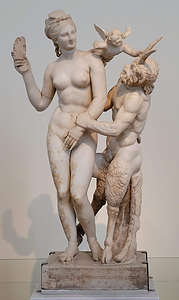 Aphrodite, Pan, and ErosI think the final sculpture I will discuss is one of my favorites: Aphrodite, Pan, and Eros - an example of Hellenistic Greek Art, which was less serious and more erotic than Classical Art. In this statue, dating to about 100 BCE, Aphrodite is playfully fending off Pan’s (half-man, half-goat) lecherous advances with her slipper. Between them, Eros (known as Cupid to the Romans) is obviously up to no good.
Aphrodite, Pan, and ErosI think the final sculpture I will discuss is one of my favorites: Aphrodite, Pan, and Eros - an example of Hellenistic Greek Art, which was less serious and more erotic than Classical Art. In this statue, dating to about 100 BCE, Aphrodite is playfully fending off Pan’s (half-man, half-goat) lecherous advances with her slipper. Between them, Eros (known as Cupid to the Romans) is obviously up to no good.
There was so much more in the museum to talk about, but these were just some of our favorites.
That evening we wrapped up our tour with a farewell dinner at the Cave of the Acropolis, in the Plaka, in the shadows of the sacred rock of the Acropolis.
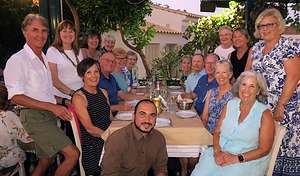
We kind of dreaded the next day - about 24 hours of travel before we would get home. Home is good too though. We were about ready.
Thank you Tassos and the people of Greece for sharing your beautiful land and rich culture with us.
αντίο και ευχαριστώ (Goodbye and thank you)
- ‹ previous
- 6 of 6
Athens location map in "high definition"
Javascript is required to view this map.
